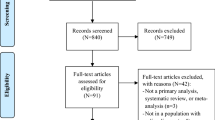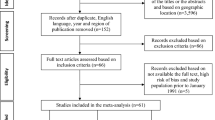Abstract
Objective
In recent years, patients with celiac disease (CeD) have been reported to have a high prevalence of fatty liver and metabolic syndrome. We conducted a systematic review and meta-analysis to assess the prevalence of fatty liver and metabolic syndrome in patients with CeD and effect of gluten-free diet in them.
Methods
The PubMed, Embase and the Cochrane Library databases were searched for original studies upto November 18, 2022. We included full-text articles published in the English language after 1990 that used well-defined criteria for CeD, fatty liver and metabolic syndrome. A random effects model was used to calculate pooled prevalence.
Results
Of 350 studies identified, 11 studies (n = 2578) were included in the analysis. On analysis of both cross-sectional and longitudinal studies, pooled prevalence of fatty liver and metabolic syndrome in treatment-naïve patients with CeD were 18.2% (95% CI 8.3–30.8%, n = 1237) and 4.3% (95% CI 2.4–6.7, n = 1239) and in those on GFD of varying duration was 28.2% (95% CI 20.7–36.4%, n = 1368) and 21.3% (95% CI 11.7–32.9%, n = 2193), respectively. There was no difference in the prevalence of fatty liver and metabolic syndrome between low- or high-income group countries.
Conclusions
Patients with CeD have a high prevalence of fatty liver and metabolic syndrome which increases further with the initiation of GFD. Patients with CeD should thus be screened and monitored for development of fatty liver and metabolic syndrome. They should be counselled appropriately regarding their diet and inclusion of physical activity in their lifestyle.
Graphical Abstract





Similar content being viewed by others
References
Makharia GK, Singh P, Catassi C et al. The global burden of coeliac disease: opportunities and challenges. Nat Rev Gastroenterol Hepatol 2022;19:313–327.
Cheng J, Brar PS, Lee AR et al. Body mass index in celiac disease: beneficial effect of a gluten-free diet. J Clin Gastroenterol 2010;44:267–271.
Kabbani TA, Goldberg A, Kelly CP et al. Body mass index and the risk of obesity in coeliac disease treated with the gluten-free diet. Aliment Pharmacol Ther 2012;35:723–729.
Singh I, Agnihotri A, Sharma A et al. Patients with celiac disease may have normal weight or may even be overweight. Indian J Gastroenterol 2016;35:20–24.
Barone M, Iannone A, Cristofori F, et al. Risk of obesity during a gluten-free diet in pediatric and adult patients with celiac disease: a systematic review with meta-analysis. Nutr Rev August 2022:nuac052.
Younossi ZM, Koenig AB, Abdelatif D et al. Global epidemiology of nonalcoholic fatty liver disease-Meta-analytic assessment of prevalence, incidence, and outcomes. Hepatology 2016;64:73–84.
Noubiap JJ, Nansseu JR, Lontchi-Yimagou E et al. Geographic distribution of metabolic syndrome and its components in the general adult population: A meta-analysis of global data from 28 million individuals. Diabetes Res Clin Pract 2022;188:109924.
Singh S, Allen AM, Wang Z, et al. Fibrosis progression in nonalcoholic fatty liver vs nonalcoholic steatohepatitis: a systematic review and meta-analysis of paired-biopsy studies. Clin Gastroenterol Hepatol 2015;13:643–654.e1–9; quiz e39–40.
Kasper P, Martin A, Lang S et al. NAFLD and cardiovascular diseases: a clinical review. Clin Res Cardiol 2021;110:921–937.
Mottillo S, Filion KB, Genest J et al. The metabolic syndrome and cardiovascular risk a systematic review and meta-analysis. J Am Coll Cardiol 2010;56:1113–1132.
Raiteri A, Granito A, Faggiano C et al. Hepatic Steatosis in Patients with Celiac Disease: The Role of Packaged Gluten-Free Foods. Nutrients 2022;14:2942.
Manka P, Sydor S, Schänzer-Ocklenburg JM et al. A Potential Role for Bile Acid Signaling in Celiac Disease-Associated Fatty Liver. Metabolites 2022;12:130.
Agarwal A, Singh A, Mehtab W et al. Patients with celiac disease are at high risk of develo** metabolic syndrome and fatty liver. Intest Res 2021;19:106–114.
Rispo A, Imperatore N, Guarino M et al. Metabolic-associated fatty liver disease (MAFLD) in coeliac disease. Liver Int 2021;41:788–798.
Remes-Troche JM, Cobos-Quevedo ODJ, Rivera-Gutiérrez X et al. Metabolic effects in patients with celiac disease, patients with nonceliac gluten sensitivity, and asymptomatic controls, after six months of a gluten-free diet. Revista de Gastroenterología de México 2020;85:109–117.
Ciccone A, Gabrieli D, Cardinale R et al. Metabolic Alterations in Celiac Disease Occurring after Following a Gluten-Free Diet. Digestion 2019;100:262–268.
Tovoli F, Negrini G, Farì R et al. Increased risk of nonalcoholic fatty liver disease in patients with coeliac disease on a gluten-free diet: beyond traditional metabolic factors. Aliment Pharmacol Ther 2018;48:538–546.
Tortora R, Rispo A, Alisi A et al. PNPLA3 rs738409 Polymorphism Predicts Development and Severity of Hepatic Steatosis but Not Metabolic Syndrome in Celiac Disease. Nutrients 2018;10:E1239.
Imperatore N, Tortora R, Testa A et al. Proton pump inhibitors as risk factor for metabolic syndrome and hepatic steatosis in coeliac disease patients on gluten-free diet. J Gastroenterol 2018;53:507–516.
Tortora R, Capone P, De Stefano G et al. Metabolic syndrome in patients with coeliac disease on a gluten-free diet. Alimentary Pharmacology & Therapeutics 2015;41:352–359.
Kabbani TA, Kelly CP, Betensky RA et al. Patients With Celiac Disease Have a Lower Prevalence of Non–Insulin-Dependent Diabetes Mellitus and Metabolic Syndrome. Gastroenterology 2013;144:912-917.e1.
Stroup DF, Berlin JA, Morton SC, et al. Meta-analysis of observational studies in epidemiology: a proposal for reporting. Meta-analysis Of Observational Studies in Epidemiology (MOOSE) group. JAMA 2000;283:2008–2012.
Revised criteria for diagnosis of coeliac disease. Report of Working Group of European Society of Paediatric Gastroenterology and Nutrition. Arch Dis Child 1990;65:909–911.
Ludvigsson JF, Leffler DA, Bai JC et al. The Oslo definitions for coeliac disease and related terms. Gut 2013;62:43–52.
Hill ID, Dirks MH, Liptak GS et al. Guideline for the diagnosis and treatment of celiac disease in children: recommendations of the North American Society for Pediatric Gastroenterology, Hepatology and Nutrition. J Pediatr Gastroenterol Nutr 2005;40:1–19.
Felber J, Aust D, Baas S, et al. [Results of a S2k-Consensus Conference of the German Society of Gastroenterolgy, Digestive- and Metabolic Diseases (DGVS) in conjunction with the German Coeliac Society (DZG) regarding coeliac disease, wheat allergy and wheat sensitivity]. Z Gastroenterol 2014;52:711–743.
Husby S, Koletzko S, Korponay-Szabó I et al. European Society Paediatric Gastroenterology, Hepatology and Nutrition Guidelines for Diagnosing Coeliac Disease 2020. J Pediatr Gastroenterol Nutr 2020;70:141–156.
Hamaguchi M, Kojima T, Itoh Y et al. The severity of ultrasonographic findings in nonalcoholic fatty liver disease reflects the metabolic syndrome and visceral fat accumulation. Am J Gastroenterol 2007;102:2708–2715.
Sabir N, Sermez Y, Kazil S et al. Correlation of abdominal fat accumulation and liver steatosis: importance of ultrasonographic and anthropometric measurements. Eur J Ultrasound 2001;14:121–128.
Ferraioli G, Wong VW-S, Castera L, et al. Liver Ultrasound Elastography: An Update to the World Federation for Ultrasound in Medicine and Biology Guidelines and Recommendations. Ultrasound Med Biol 2018;44:2419–2440.
Rout G, Kedia S, Nayak B et al. Controlled Attenuation Parameter for Assessment of Hepatic Steatosis in Indian Patients. J Clin Exp Hepatol 2019;9:13–21.
Authors/Task Force Members, Rydén L, Grant PJ, et al. ESC Guidelines on diabetes, pre-diabetes, and cardiovascular diseases developed in collaboration with the EASD: the Task Force on diabetes, pre-diabetes, and cardiovascular diseases of the European Society of Cardiology (ESC) and developed in collaboration with the European Association for the Study of Diabetes (EASD). Eur Heart J 2013;34:3035–3087.
Alberti KGMM, Zimmet P, Shaw J. Metabolic syndrome--a new world-wide definition. A Consensus Statement from the International Diabetes Federation. Diabet Med 2006;23:469–480.
Misra A, Chowbey P, Makkar BM et al. Consensus statement for diagnosis of obesity, abdominal obesity and the metabolic syndrome for Asian Indians and recommendations for physical activity, medical and surgical management. J Assoc Physicians India 2009;57:163–170.
Sinay I, Costa, de Loreto. Consenso Latinoamericano de la Asociación Latinoamericana de Diabetes (ALAD): Epidemiología, Diagnóstico, Control, Prevención y Tratamiento del Síndrome Metabólico en Adultos. https://www.scienceopen.com/document?vid=e533b22a-02e7-4eeb-834a-165d8f5121c2. Accessed June 27, 2022.
Study Quality Assessment Tools | NHLBI, NIH. https://www.nhlbi.nih.gov/health-topics/study-quality-assessment-tools. Accessed July 4, 2022.
Altman DG, Bland JM. How to obtain the P value from a confidence interval. BMJ 2011;343:d2304.
Rosenblad A. Introduction to Meta-Analysis by Michael Borenstein, Larry V. Hedges, Julian P.T. Higgins, Hannah R. Rothstein. International Statistical Review 2009;77:478–479.
Egger M, Davey Smith G, Schneider M et al. Bias in meta-analysis detected by a simple, graphical test. BMJ 1997;315:629–634.
Valvano M, Longo S, Stefanelli G et al. Celiac Disease, Gluten-Free Diet, and Metabolic and Liver Disorders. Nutrients 2020;12:940.
Taetzsch A, Das SK, Brown C et al. Are Gluten-Free Diets More Nutritious? An Evaluation of Self-Selected and Recommended Gluten-Free and Gluten-Containing Dietary Patterns. Nutrients 2018;10:E1881.
Barone M, Della Valle N, Rosania R et al. A comparison of the nutritional status between adult celiac patients on a long-term, strictly gluten-free diet and healthy subjects. Eur J Clin Nutr 2016;70:23–27.
Miranda J, Lasa A, Bustamante MA et al. Nutritional differences between a gluten-free diet and a diet containing equivalent products with gluten. Plant Foods Hum Nutr 2014;69:182–187.
Sainsbury K, Halmos EP, Knowles S et al. Maintenance of a gluten free diet in coeliac disease: The roles of self-regulation, habit, psychological resources, motivation, support, and goal priority. Appetite 2018;125:356–366.
Vereczkei Z, Farkas N, Hegyi P et al. It Is High Time for Personalized Dietary Counseling in Celiac Disease: A Systematic Review and Meta-Analysis on Body Composition. Nutrients 2021;13:2947.
Gami AS, Witt BJ, Howard DE et al. Metabolic syndrome and risk of incident cardiovascular events and death: a systematic review and meta-analysis of longitudinal studies. J Am Coll Cardiol 2007;49:403–414.
Chen J, Muntner P, Hamm LL, et al. The metabolic syndrome and chronic kidney disease in U.S. adults. Ann Intern Med 2004;140:167–174.
Emilsson L, Lebwohl B, Sundström J et al. Cardiovascular disease in patients with coeliac disease: A systematic review and meta-analysis. Dig Liver Dis 2015;47:847–852.
Ng CH, Lim WH, Hui Lim GE, et al. Mortality Outcomes by Fibrosis Stage in Nonalcoholic Fatty Liver Disease: A Systematic Review and Meta-analysis. Clin Gastroenterol Hepatol May 2022:S1542–3565(22)00439–6.
Younossi Z, Anstee QM, Marietti M et al. Global burden of NAFLD and NASH: trends, predictions, risk factors and prevention. Nat Rev Gastroenterol Hepatol 2018;15:11–20.
Saklayen MG. The Global Epidemic of the Metabolic Syndrome. Curr Hypertens Rep 2018;20:12.
Funding
No financial disclosures.
Author information
Authors and Affiliations
Contributions
NA, AA, and GM completed study design. Literature search and data extraction were carried out by NA and HA. Assessment of quality of included studies was carried out by NA and HA under the supervision of AA and GM. Qualitative synthesis was carried out by all authors. Data analysis was performed by NA and VD. AA and GM consulted on the analysis. All authors were involved in the interpretation of the results. NA and HA created the figures. Figure 4 was created by NA using biorender.com. NA and HA drafted the initial manuscript. The manuscript was revised by NA, AA, and GM and approved for final submission by all authors. Writing Assistance: None. Guarantor of article: Dr Govind K Makharia, MBBS, MD, DM.
Corresponding author
Ethics declarations
Conflict of interest
We declare no competing interests.
Ethical approval
Not applicable.
Informed consent
Not applicable.
Permission to reproduce material from other sources
Not Required.
Additional information
Publisher's Note
Springer Nature remains neutral with regard to jurisdictional claims in published maps and institutional affiliations.
Supplementary Information
Below is the link to the electronic supplementary material.
Rights and permissions
Springer Nature or its licensor (e.g. a society or other partner) holds exclusive rights to this article under a publishing agreement with the author(s) or other rightsholder(s); author self-archiving of the accepted manuscript version of this article is solely governed by the terms of such publishing agreement and applicable law.
About this article
Cite this article
Aggarwal, N., Agarwal, A., Alarouri, H. et al. Patients with Celiac Disease Have High Prevalence of Fatty Liver and Metabolic Syndrome. Dig Dis Sci (2024). https://doi.org/10.1007/s10620-024-08426-5
Received:
Accepted:
Published:
DOI: https://doi.org/10.1007/s10620-024-08426-5




